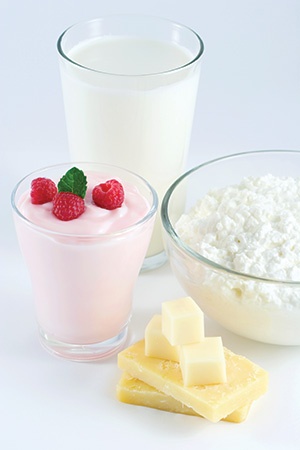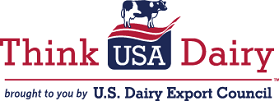-
Delivering Lactose-Free Options with Dairy
By Terri Rexroat September 8, 2017- Tweet
 Products with free-from claims, such as lactose-free, seem to be multiplying overnight. According to Innova Market Insights, 2% of new global product introductions in 2015 included lactose free claims.1 This number is rising as manufacturers take the opportunity to contribute lactose-free innovations using dairy ingredients.
Products with free-from claims, such as lactose-free, seem to be multiplying overnight. According to Innova Market Insights, 2% of new global product introductions in 2015 included lactose free claims.1 This number is rising as manufacturers take the opportunity to contribute lactose-free innovations using dairy ingredients.A good portion of new lactose-free products also are dairy-free, but eliminating dairy doesn’t have to be the solution. As explained by Dietitian, Amy Goodson, the nutrition, taste and functionality of dairy is hard to match with alternatives to dairy. In her Dairy Good article, Amy gives consumers ways to reduce lactose in their diets while still benefiting from clean and nourishing dairy.
Profiling lactose-free consumers
Why is lactose-free so popular? Online resources and diverse societies are raising awareness of lactose intolerant symptoms and health effects. Whether consumers are diagnosed or self-assessed, they are reconfiguring their diets to avoid lactose. However, lactose is a natural sugar that has little-to-no effect on consumers who are not lactose intolerant. Avoiding lactose isn’t advantageous if the body has no issues digesting the nutrient.
Food and beverage formulators can produce reduced-lactose products without eliminating or avoiding dairy. Many cheeses and dairy ingredients have little to no lactose. If they do contain higher levels, there are a variety of ways to reduce the lactose during formulation. Consumers can then still benefit from the vitamins and health characteristics of dairy.
Using dairy in lactose-free options
Consumers clearly want more choices personalized to their health needs, and dairy has not fallen behind in meeting requests. Manufacturers can formulate a lactose-free product without eliminating the goodness of dairy by enlisting specific technology and processes. For example, lactose can be removed from many ready-to-drink products, including sports nutrition beverages, using lactase enzymes.1 Lactase enzymes break down the lactose during processing.1
Sports nutrition is the second most active category for lactose free development, behind dairy applications. Approximately 5.5% of sports nutrition product launches in 2015 featured lactose-free claims. That is a 39% increase from 2014.1 To not lose the essential recovery, satiety and nutrition benefits, sports nutrition formulators are staying on-trend, eliminating lactose while still including high-quality whey protein.
Dairy ingredients offer nutrients that are hard to match with dairy alternatives and dairy-free foods. Using dairy ingredients does not mean sacrificing consumer-desired free-from claims, including lactose-free. There are many solutions to fitting dairy ingredients to your formulation needs and marketable claims. Click here to learn more and explore your ingredient and product offerings.
1Innova Market Insights. Briefing Series. Lactose Free: Varied Approaches to Formulation and Positioning. October 2016. Accessed on August 22, 2017.
Most Popular Posts
Find by Date, Geography and Dairy Product
- September 2015 (6)
- December 2015 (5)
- September 2016 (5)
- December 2016 (5)
- June 2017 (5)
- February 2015 (4)
- March 2015 (4)
- April 2015 (4)
- May 2015 (4)
- June 2015 (4)
- July 2015 (4)
- November 2015 (4)
- January 2016 (4)
- March 2016 (4)
- June 2016 (4)
- August 2016 (4)
- October 2016 (4)
- November 2016 (4)
- February 2017 (4)
- March 2017 (4)
- April 2017 (4)
- November 2013 (3)
- October 2015 (3)
- February 2016 (3)
- April 2016 (3)
- May 2016 (3)
- July 2016 (3)
- January 2017 (3)
- May 2017 (3)
- July 2017 (3)
- August 2017 (3)
- September 2017 (3)
- October 2014 (2)
- August 2015 (2)
- October 2017 (2)
- December 2017 (2)
- July 2020 (2)
- December 2013 (1)
- February 2014 (1)
- June 2014 (1)
- August 2014 (1)
- September 2014 (1)
- November 2014 (1)
- November 2017 (1)
- January 2018 (1)
- February 2018 (1)
- May 2018 (1)
- June 2018 (1)
- July 2018 (1)
- August 2018 (1)
- September 2018 (1)
- October 2018 (1)
- November 2018 (1)
- February 2019 (1)
- March 2019 (1)
- April 2019 (1)
- July 2019 (1)
- October 2019 (1)
- March 2020 (1)
- April 2020 (1)
- June 2020 (1)
- October 2020 (1)
- November 2020 (1)
- March 2021 (1)
- April 2021 (1)
- June 2021 (1)
- August 2021 (1)
- February 2022 (1)
- June 2022 (1)
- September 2022 (1)
- October 2022 (1)
- November 2022 (1)
- February 2023 (1)
- April 2023 (1)
- USDEC Staff (65)
- Kara McDonald (24)
- Terri Rexroat (15)
- John Klees (15)
- Kristi Saitama (9)
- Angelique Hollister (8)
- Vikki Nicholson-West (8)
- Shannon Koski (8)
- Rohit Kapoor (3)
- Keith Meyer (2)
- Moises Torres-Gonzalez (2)
- Amy Foor (2)
- Alan Levitt (1)
- Tom Vilsack, President and CEO (1)
- Allison Guzman (1)
- Dacia Whitsett-Morrow (1)
- Ryan Hopkin (1)
- Matthew Pikosky (1)
- Ross Christieson (1)
- Nina Halal (1)
- Mary Wilcox (1)
Keywords
- 2018 beverage trends (3)
- 2018 Food Innovations (1)
- 2018 food trends (3)
- Asia (1)
- Avian Influenza (1)
- Award-winning cheeses (3)
- Awards (2)
- Back-to-School (1)
- Baked Goods (1)
- Bakery (1)
- Beer (2)
- Beverage (5)
- Breakfast (1)
- Butter (6)
- Casein (2)
- Cheese (48)
- cheese flavors (2)
- Cheese Pairing (3)
- Cheesemaking (5)
- Child Nutrition (3)
- China (6)
- Clean Label (6)
- Common Food Names (1)
- Consistent Supply (3)
- Consumer Insights (48)
- Consumer Promotional Tools (1)
- Consumer Trends (15)
- Contest (1)
- craft foods (2)
- Cultured dairy (1)
- Dairy (17)
- Dairy Detective (4)
- Dairy Fat (1)
- Dairy Futures and Options (3)
- Dairy Ingredients (82)
- Dairy Ingredients Symposium (1)
- Dairy Permeate (1)
- Dairy Product Solids (1)
- Dairy Production (5)
- Dairy Proteins (35)
- Dairy Resources (23)
- Dairy Trade (1)
- Dairy Trends (10)
- Dessert (1)
- Digestive Health (2)
- Donna Berry (1)
- Drinkable yogurt (1)
- Early Childhood Development (1)
- Educational Tools (1)
- Egg Replacement (2)
- Egg Substitution (1)
- Egypt (1)
- Energy (4)
- Environment (2)
- Europe (1)
- Export Data (8)
- Exports (7)
- Farming (1)
- Flavor Trends (1)
- Follow-on Formula (1)
- Food Aid (2)
- Food and Beverage Trends (7)
- Food Production (3)
- Food Technology (3)
- Foodservice (2)
- Free From Claims (1)
- Full-fat Dairy (1)
- Geographical Indications (GIs) (1)
- GHG (1)
- Global (74)
- Global Dairy Market (2)
- Global Demand (2)
- Global Market (4)
- Global Supply (1)
- Greek Yogurt (1)
- Gulfood (2)
- Gut Health (1)
- Health (1)
- Healthy Aging (8)
- Healthy Indulgence (1)
- Heavy Cream (1)
- High Quality Protein (11)
- Holiday Dessert (2)
- Holidays (1)
- IFT (7)
- IFT2016 (1)
- IFT2018 (2)
- Infant Formula (1)
- Infographic (3)
- Innova Market Insights (4)
- Innovation (2)
- Japan (7)
- Lactose (8)
- Lactose-free (1)
- LinkedIn (1)
- Malnutrition (2)
- Market Insights (67)
- Methane (1)
- Mexico (2)
- Micellar Casein (3)
- Middle East (2)
- Middle East/North Africa (9)
- Milk (8)
- Milk Permeate (2)
- Milk Powder (10)
- Milk Protein (19)
- Milkfat (5)
- Millennials (3)
- MPC (4)
- MPI (1)
- Muscle Maintenance (1)
- Muscle Recovery (2)
- Muscle Synthesis (2)
- NAFTA (1)
- New Product Introductions (1)
- New Year's Resolutions (1)
- Nonfat Dry Milk/Skim Milk Powder (4)
- Nutrition (21)
- Nutrition Research (14)
- Obesity (1)
- Overnutrition (1)
- Permeate (19)
- Price Volatility (2)
- Probiotics (2)
- Product Innovation (3)
- Protein (33)
- Prototypes (1)
- Record (3)
- Reduced-Fat (1)
- Research & Data (1)
- Resources and Tools (8)
- Risk Management (3)
- RTD Coffee and Tea (1)
- Salon Culinaire (1)
- Salt Substitute (1)
- Savory Flavors (1)
- Science and Research (3)
- Service Providers (1)
- Simple Ingredients (1)
- Singapore (1)
- Skimmed Milk Powder (2)
- Smoothies (1)
- Snack Trends (3)
- Snacking (4)
- Snacks (1)
- Sodium (3)
- Sodium Reduction (4)
- South Korea (3)
- Southeast Asia (9)
- Sports Nutrition (4)
- Stewardship (1)
- Student Competition (1)
- Supplier Directory (1)
- Supply (4)
- Sustainability (7)
- Sustainability Awards (1)
- Sustainable Nutrition (7)
- Technology (1)
- ThinkUSAdairy (2)
- Toddler Formula (1)
- Trade Data (1)
- U.S. Dairy Industry (11)
- U.S. Dairy Industry Growth (6)
- U.S. Dairy Partnerships (4)
- U.S. Dairy Products (15)
- UK (1)
- United Arab Emirates (5)
- United States (10)
- USDEC Events (44)
- Value (3)
- Vietnam (5)
- Volatility (1)
- Volume (4)
- Waste Reduction (1)
- Weight Management (6)
- Whey (14)
- Whey Ingredients (3)
- Whey Permeate (5)
- Whey Products (3)
- Whey Protein (47)
- Whey Protein Concentrate (3)
- Whey Protein Isolate (5)
- Whole-milk dairy (1)
- Wine (2)
- World Championship Cheese Contest (1)
- World Cheese Awards (2)
- World Milk Day (1)
- WPC (4)
- WPI (1)
- Yogurt (6)


